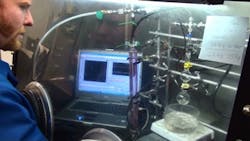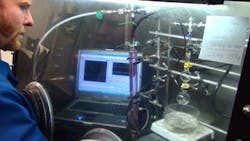Liquids Ease Acid-Gas Removal
Acid-gas-binding organic liquids promise a more effective and less energy-intensive method to capture gases such as carbon dioxide and sulfur dioxide, say researchers at the U.S. Department of Energy's Pacific Northwest National Laboratory (PNNL), Richland, Wash. The liquids can capture twice as much gas by weight as the monoethanolamine (MEA) system now widely used for CO2 removal, yet have half the specific heat, explains David Heldebrant, a senior research scientist at the lab. "Power plants could easily retrofit to use our process as a direct replacement for existing technology," he notes. MEA's corrosiveness requires its dilution with water. "Current methods used to capture and release CO2 from power plants use a lot of energy because they pump and heat an excess of water during the process," says Heldebrant. The liquids PNNL researchers are using contain no water and capture gas at close to ambient temperature. Initial work focused on CO2 removal but now variants target SO2, carbonyl sulfide and carbon disulfide. Each acid-gas-binding liquid consists of a mixture of an alcohol and a base. The liquid binds gas to form a colored ionic liquid. The system is selective because it chemically binds CO2 as liquid alkylcarbonate salts, and the other gases as liquid alkyl-sulfite, alkylthiocarbonate and alkyldithiocarbonate salts. Heating the liquid to a temperature between ambient and its boiling point (about 125°C) releases the gas and returns the liquid to its initial state. These systems are the first to show reversible binding and release of COS, CS2 and SO2, claim the researchers.
Gas Capture
Figure 1. Researchers can tailor liquids to absorb carbon dioxide, sulfur dioxide, carbonyl sulfide and carbon disulfide. (For a video showing carbon dioxide being released from the liquid, click here.) Source: Pacific Northwest National Laboratory.The liquids exhibit high gravimetric capacities for the gases. Current lab-scale results show, e.g., 25–27 wt. % for CO2 versus 7 wt. % for a 30% MEA solution in water. "There's considerable room to improve results," adds Heldebrant. Changing the structure of the alcohol or the base can alter physical and chemical properties, he explains. The approach also may suit removing multiple gases but at this point researchers don't know whether an all-in-one system with a blend of liquids or a stepwise approach makes most sense. Researchers so far have run the liquids for CO2 and SO2 removal through five regeneration cycles. "There's been minimal evaporative loss and no absorption performance decline," says Heldebrant. The next step in the development is to run gas-specific trials in a wetted-wall column. PNNL engineers now are designing a unit, which probably will have a 100-ml to 1-L capacity, notes Heldebrant. Tests should begin early in 2010 and should allow pinning down economics by the end of the year. This hopefully will lead to piloting in early 2011, he says. PNNL already has received inquiries from several chemical and other companies, and would like to have an industrial partner involved in the piloting. Heldebrant says the key challenges are to cut costs of the liquids — the researchers plan to look at new ways to make them — and how to deal with any water that gets into the system — work on easing phase separation of water will start by the end of 2009. The economic analysis will factor in the need for an initial water-removal step, he adds. Researchers also are working on second-generation systems that use a single compound instead of a mixture. This won't pose any tradeoffs in tailoring, will make modeling easier, and may offer higher absorption capacity, explains Heldebrant. Such a liquid for CO2 capture already has been developed and tested, he adds.
